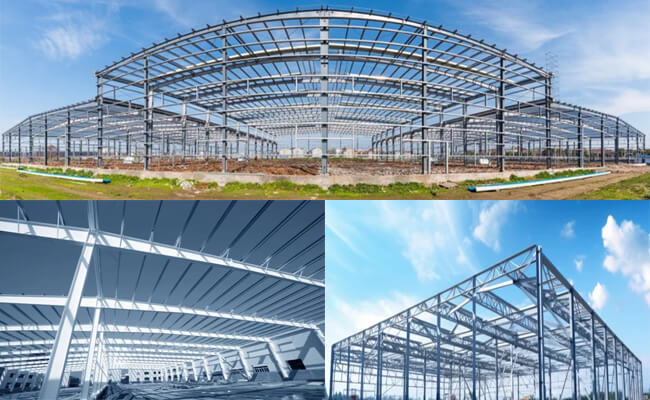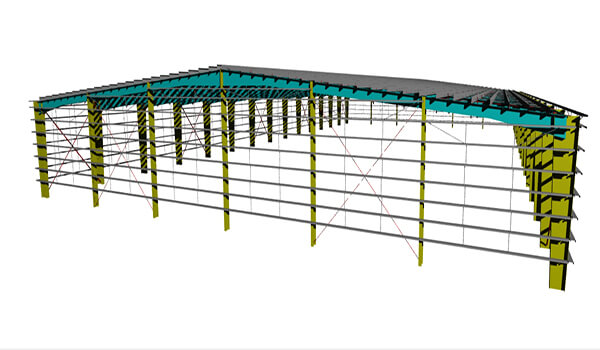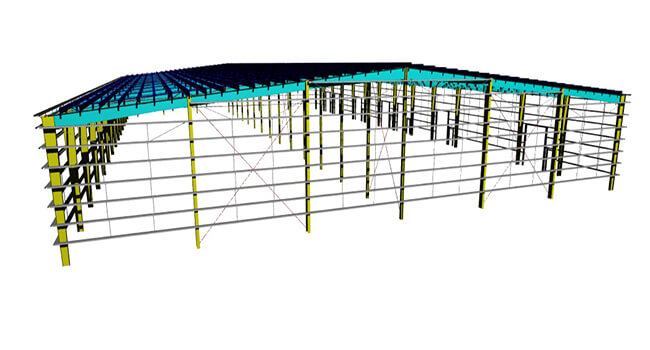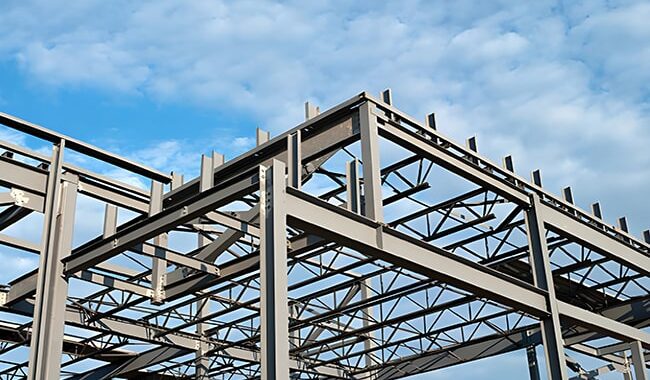A steel frame is a structure made of steel, usually connected by welding, bolting, or riveting steel beams, columns, bracing,…
With the rise of the industrial and logistics industries, the design demand for steel warehouse buildings has been increasing. To provide a high volume ratio of warehouses, enterprises have begun to choose large-span steel warehouse buildings. These buildings have the advantages of high space utilization and flexibility.

Structural design of large-span steel warehouse buildings:
Large-span steel warehouse buildings usually use portal steel frame structures, and steel columns and roof beams use H-shaped steel. The portal steel frame has the advantages of low processing cost, bolt connection of various components, and simple and convenient construction. It has always been the preferred design solution for steel structure warehouses.
Large-span steel warehouse buildings usually refer to warehouses with a horizontal span of more than 30 meters. They are mainly suitable for industrial large-span workshops, hangars and assembly workshops, large warehouses, gymnasiums, exhibition halls, airports, and high-speed rail waiting halls.
150′ (45.7m) large-span steel warehouse buildings:
150ft clear span without a center column.

Advantages:
1. Increase the utilization of internal space: The design without a central column makes the internal space of the warehouse more open, and the storage and channel design of goods are more flexible. It is suitable for items that require ample storage space, such as mechanical equipment and oversized goods. Space use can be maximized without the central column’s restriction, and storage efficiency can be improved.
2. Facilitate the installation of automated equipment: In modern warehouses, automated equipment (such as stackers, automatic shelves, etc.) requires a lot of space. A design without a central column can simplify the equipment layout and improve the level of warehouse automation.
Disadvantages:
1. High structural cost: The structure without a central column must withstand a larger span, so more vital structural elements such as beams and columns must be used. This means more steel is used, and the overall material cost is higher. A more complex connection design is also required to ensure stability.
2. Poor structural stability: If the span is too large, relying solely on external columns and beams to support the entire structure may result in less stability than a design with a central column. Therefore, special consideration needs to be given to the strength and stability of the steel in the design to ensure safety requirements such as wind and earthquake resistance.
150ft is divided into two spans, 75ft + 75ft
A middle column is added in the middle of the 150-ft span, divided into two spans, 75ft + 75ft.

Advantages:
1. More stable structure: In a large-span structure, adding a middle column can effectively share the load, reduce the span of beams and columns, and make the structure more stable. Especially when the load is significant, adding a middle column helps improve the warehouse’s load-bearing capacity and safety.
2. Reduce material costs: By sharing the load with the middle column, the size of the main beam and the amount of steel used can be reduced, thereby reducing the overall material cost. The steel used is saved by 30%, and the material and construction costs are more economical. It is an economical choice for projects with limited budgets.
Disadvantages:
Affect the internal layout of the warehouse: The middle column’s presence will affect the warehouse’s spatial layout, especially in places where storage requires more passages or equipment movement. The middle column may limit stored goods’ size, access efficiency, or stacking method.
Summary:
The design with a central column is suitable for warehouses with limited budgets and moderate structural spans (such as 20-30 meters), especially when there is no need for extensive space utilization. It can effectively reduce costs and improve structural stability.
The design without a central column suits warehouses with high space requirements and flexible space use, especially automated warehouses, heavy equipment storage, etc. Still, due to its high cost, it is suitable for projects with a relatively generous budget.
Advantages of steel structures for large-span buildings:
Traditional concrete structures cannot quickly achieve the internal use space of a large span. Only steel structures can promptly reach large spans and high-use spaces, manifesting their unique advantages.
Steel’s muscular rigidity and strength ensure the stability and safety of large buildings. Prefabricated components and standardized design make on-site assembly more efficient. Steel structures can be processed and installed quickly, which can help companies put steel into use and increase revenue in advance.
In addition, the processing and installation of steel structures are relatively environmentally friendly and will not cause substantial environmental pollution and noise pollution; steel is a 100% recyclable material, and steel structure buildings are standard ecologically friendly buildings. The recycling and reuse of steel conforms to environmental protection and significantly saves costs.
Large-span steel structure buildings have been used in many fields. Large-span steel structures and buildings have also contributed to the country’s rapid development and brought great convenience to enterprises and people’s daily lives. Large-span steel structure buildings have replaced traditional buildings in many fields due to their excellent stability, strong earthquake resistance, fast construction speed, environmental protection and sustainability, and other advantages. They have become a new architectural trend.














